1. Transcription sets the stage for Translation
As you’ve learned in previous tutorials, the central dogma of molecular genetics is DNA makes RNA makes protein.
When cells make protein, they transfer information from a sequence of nucleotides into a sequence of amino acids. If you think about nucleic acids (written in nucleotides) and protein (written in amino acids) as different languages, then protein synthesis is a shift in molecular language. As a result, protein synthesis is called translation.
During transcription, the phase preceding protein synthesis, the cell creates the various types of RNA that make protein synthesis possible. To review the big picture of transcription and translation, label this diagram.
[qwiz qrecord_id=”sciencemusicvideosMeister1961-Transcription, Translation Review (HS)”]
[h]Transcription and translation
[q labels = “top”]
[l]DNA
[fx] No. Please try again.
[f*] Great!
[l]cell membrane
[fx] No. Please try again.
[f*] Good!
[l]nuclear membrane
[fx] No, that’s not correct. Please try again.
[f*] Excellent!
[l]cytoplasm
[fx] No. Please try again.
[f*] Correct!
[l]mRNA
[fx] No, that’s not correct. Please try again.
[f*] Excellent!
[l]tRNA
[fx] No. Please try again.
[f*] Correct!
[l]RNA
[fx] No. Please try again.
[f*] Correct!
[l]nuclear pore
[fx] No, that’s not correct. Please try again.
[f*] Great!
[l]protein
[fx] No. Please try again.
[f*] Great!
[l]ribosome/rRNA
[fx] No. Please try again.
[f*] Good!
[l]transcription
[fx] No, that’s not correct. Please try again.
[f*] Correct!
[/qwiz]
Note the function of each of type of RNA:
- mRNA/messenger RNA (11) is a molecular message that specifies the sequence of amino acids in a protein (9).
- rRNA/ribosomal RNA, along with protein, is what makes up the ribosome (10). Think of ribosomes as “protein factories” that can make any kind of protein.
- tRNA/transfer RNA (8) brings amino acids to the ribosome.
Continue reading to learn more about each of the key players in translation.
2. Making protein is the goal of translation
Proteins are the action molecules of cells and organisms. Most of life’s key functions (like movement, defense, or enzymatic control of chemical reactions) are based on proteins. In fact, what you’ll see as we move through this course is that life is a system of genes (made of nucleic acids) that specify proteins, which reproduce those genes.
In a previous module in this course, you’ve already learned about the chemistry of proteins. Here’s a quick review of the basics. If you find, as you read what’s below, that you feel hazy on what we learned earlier this year, definitely go back to review (access the tutorials through the main menu above), and then come back here.
1. Proteins are polymers of amino acids. As shown below, each amino acid consists of a central carbon atom. The central carbon is bonded to an —NH2 (an amino group) on one side, a –COOH (carboxylic acid group) on the other side, and a side chain (also known as an “R-group”). The side chains vary in their composition and chemistry, and can be polar/hydrophilic, non-polar/hydrophobic, acidic, or basic.
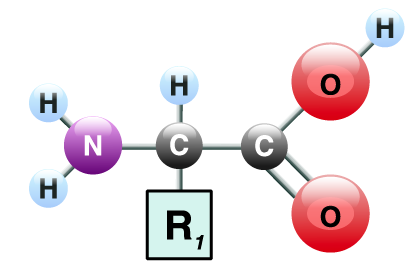
2. There are 20 amino acids. You can think of them as an alphabet. In the same way that English uses the 26 letters of the alphabet to create hundreds of thousands of words, cells use various combinations of amino acids to create hundreds of thousands of proteins. As a result, proteins are the most diverse macromolecule.
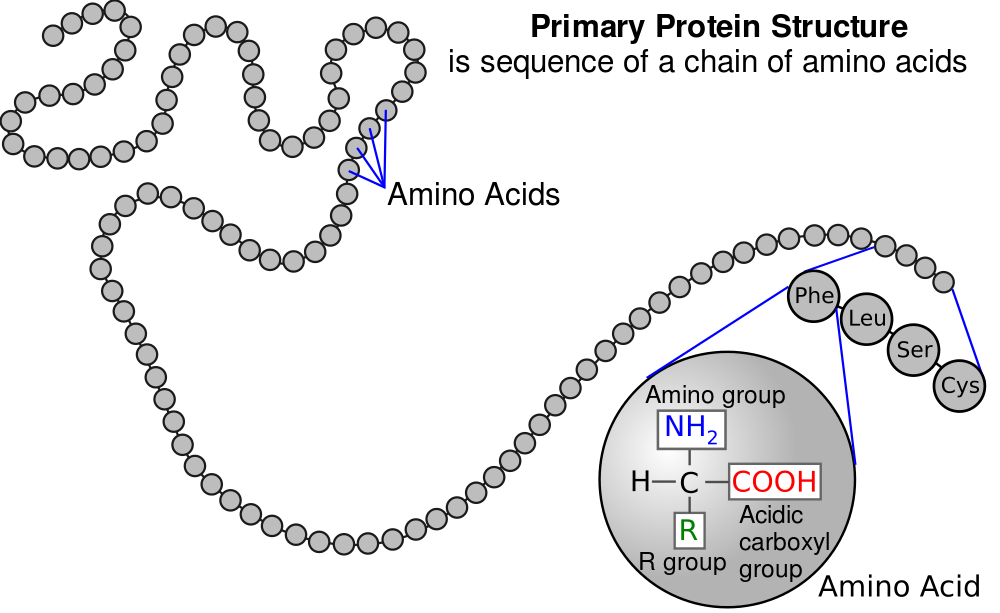
3. In diagrams about proteins and protein synthesis, amino acids are represented by three letter abbreviations. In what’s above, Phe represents the amino acid phenylalanine, leu represents leucine, and so on.
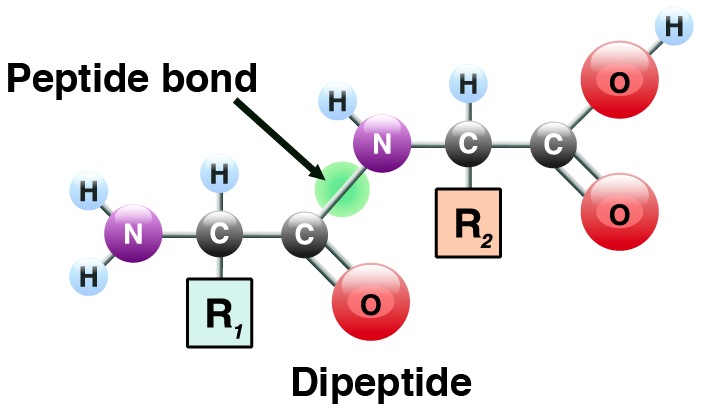
4. Amino acids in proteins are joined by peptide bonds (find the bond indicated by the green circle above).
5. Two linked amino acids form a dipeptide (see above).
6. A chain of amino acids that are linked together is known as a polypeptide. A polypeptide can as short as a few amino acids, or hundreds of amino acids long.
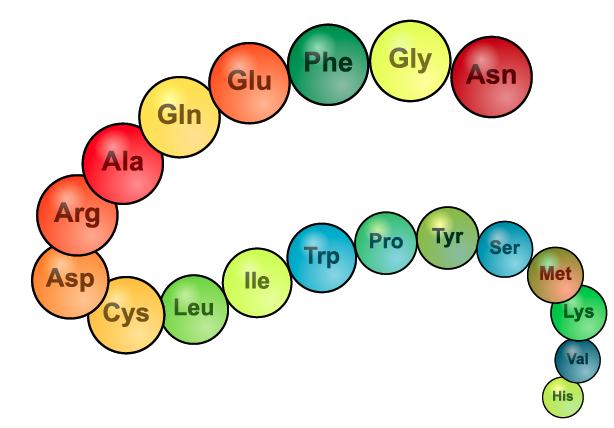
7. Interactions between amino acids cause a polypeptide to fold into a specific shape. This leads to the notion of levels of protein structure.
- Primary structure is the genetically determined, linear sequence of amino acids in a polypeptide chain.
- Secondary structure results from hydrogen bonds that form between —COOH (carbonyl) and
–OH (hydroxyl) groups within the polypeptide backbone. This results in alpha helices (think of a corkscrew), or beta pleated sheets (think of a piece of paper with many parallel folds).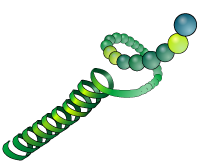
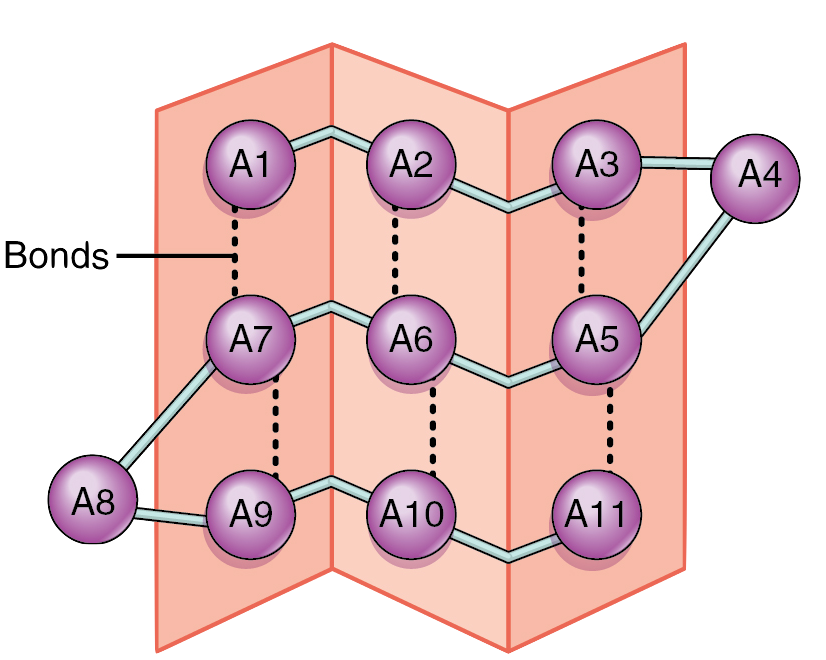
Alpha Helix Beta pleated sheet - Tertiary structure results from interaction between amino acid side chains, resulting in complex turns and loops.|
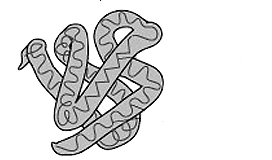
- Quaternary (4th-level) structure results from interactions between separate polypeptide chains.

8. The shape that emerges from these interactions determines a protein’s function. For example, the enzyme shown below will only be able to interact with its substrate if it has a specific shape.
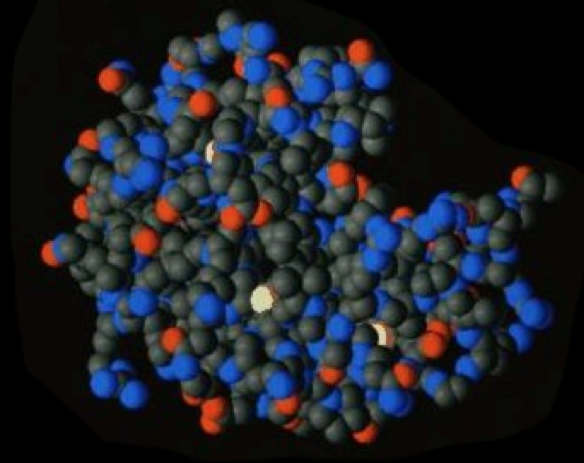
3. Protein Review Quiz
[qwiz random = “FALSE” qrecord_id=”sciencemusicvideosMeister1961-Protein Review (HS)”][h]
Review Quiz: Protein Chemistry and Structure
[i]
[q json=”true” multiple_choice=”true” xx=”2″ dataset_id=”SMV_biochem_7_amino acids and peptide bonds|e911c8e02dbfa” question_number=”7″] In the diagram below, which number indicates the part that varies from one amino acid to the next?
[c]IDE=[Qq]
[f]IE5vLiAmIzgyMjA7MSYjODIyMTsgaXMgdGhlIGNlbnRyYWwgY2FyYm9uLCB3aGljaCBpcyB0aGUgc2FtZSBpbiBldmVyeSBhbWlubyBhY2lkLg==[Qq]
[c]IDI=[Qq]
[f]IE5vLiAmIzgyMjA7MiYjODIyMTsgaXMgYW4gYW1pbm8gZ3JvdXAsIHdoaWNoIGlzIHRoZSBzYW1lIGluIGV2ZXJ5IGFtaW5vIGFjaWQu[Qq]
[c]IDM=[Qq]
[f]IE5vICYjODIyMDszJiM4MjIxOyBpcyB0aGUgY2FyYm94eWxpYyBhY2lkLCB3aGljaCBpcyB0aGUgc2FtZSBpbiBldmVyeSBhbWlubyBhY2lkLg==[Qq]
[c]ID Q=[Qq]
[f]IFllcyEgJiM4MjIwOzQmIzgyMjE7IGlzIHRoZSAmIzgyMjA7UiBncm91cCwmIzgyMjE7IHRoZSBwYXJ0IHRoYXQgY2FuIHZhcnkgZnJvbSBvbmUgYW1pbm8gYWNpZCB0byB0aGUgbmV4dC4=[Qq]
[q json=”true” xx=”2″ dataset_id=”SMV_biochem_7_amino acids and peptide bonds|e90d908aa07fa” question_number=”8″] In the diagram below, which number indicates a peptide bond?
[textentry single_char=”true”]
[c]ID Q=[Qq]
[f]IEV4Y2VsbGVudCEgJiM4MjIwOzQmIzgyMjE7IGlzIHBvaW50aW5nIHRvIHRoZSBwZXB0aWRlIGJvbmQu[Qq]
[c]IEVudGVyIHdvcmQ=[Qq]
[f]IE5vLg==[Qq]
[c]ICo=[Qq]
[f]IE5vLiBGaW5kIHRoZSBib25kIHRoYXQgY29ubmVjdHMgdGhlIGFtaW5vIGFjaWRzIGF0ICYjODIyMDsxJiM4MjIxOyBhbmQgJiM4MjIwOzMmIzgyMjE7ICh0aGUgcmVhY3RhbnRzKSBpbiB0aGUgZGlwZXB0aWRlIGF0ICYjODIyMDs1JiM4MjIxOyAodGhlIHByb2R1Y3QpLiBSZW1lbWJlciB0aGF0IHBlcHRpZGUgYm9uZHMgaW52b2x2ZSB0aGUgcmVtb3ZhbCBvZiBhbiAmIzgyMjA7SCYjODIyMTsgYW5kIGFuICYjODIyMDstT0gmIzgyMjE7IHRvIGZvcm0gYSB3YXRlciBtb2xlY3VsZS4=[Qq]
[q] The linear sequence of amino acids in a protein is also known as its [hangman] structure .
[c]IHByaW1hcnk=[Qq]
[f]IEdyZWF0IQ==[Qq]
[q] In the diagram below, the spheres with three letter abbreviations represent [hangman] acids, which are the [hangman] of proteins.
[c]IGFtaW5v[Qq]
[f]IEdvb2Qh[Qq]
[c]IG1vbm9tZXJz[Qq]
[f]IENvcnJlY3Qh[Qq]
[q] The bond shown at “5” below is a [hangman] bond. The overall shape that these bonds create within proteins is referred to as an alpha [hangman].
[c]IGh5ZHJvZ2Vu[Qq]
[f]IEV4Y2VsbGVudCE=[Qq]
[c]IGhlbGl4[Qq]
[f]IENvcnJlY3Qh[Qq]
[q multiple_choice=”true”] In the diagram below, primary structure is indicated by
[c]IG M=[Qq]
[f]IEV4Y2VsbGVudC4gTGV0dGVyICYjODIyMDtjJiM4MjIxOyByZXByZXNlbnRzIHByaW1hcnkgc3RydWN0dXJlLg==[Qq]
[c]IGQ=[Qq]
[f]IE5vLiBUaGUgcHJpbWFyeSBzdHJ1Y3R1cmUgaXMgdGhlIGxpbmVhciBzZXF1ZW5jZSBvZiBhbWlubyBhY2lkcy4=[Qq]
[c]IGo=[Qq]
[f]IE5vLiBMZXR0ZXIgJiM4MjIwO0omIzgyMjE7IGlzIHNob3dpbmcgdGhlIHRoaXJkIGxldmVsICh0ZXJ0aWFyeSBsZXZlbCkgb2YgcHJvdGVpbiBzdHJ1Y3R1cmUuIFRoZSBwcmltYXJ5IHN0cnVjdHVyZSBpcyB0aGUgbGluZWFyIHNlcXVlbmNlIG9mIGFtaW5vIGFjaWRzLg==[Qq]
[c]IGs=[Qq]
[f]IE5vLiBMZXR0ZXIgJiM4MjIwO0smIzgyMjE7IGlzIHNob3dpbmcgNHRoIGxldmVsLCBvciBxdWF0ZXJuYXJ5IHN0cnVjdHVyZS4gUHJpbWFyeSBzdHJ1Y3R1cmUgaXMgdGhlIGxpbmVhciBzZXF1ZW5jZSBvZiBhbWlubyBhY2lkcy4=[Qq]
[q multiple_choice=”true”] In the diagram below, secondary structure is indicated by
[c]IGM=[Qq]
[f]IE5vLiBMZXR0ZXIgJiM4MjIwO2MmIzgyMjE7IHJlcHJlc2VudHMgcHJpbWFyeSBzdHJ1Y3R1cmUuIFNlY29uZGFyeSBzdHJ1Y3R1cmUgaW52b2x2ZXMgaGVsaWNlcyBhbmQgcGxlYXRlZCBzaGVldHMu[Qq]
[c]IG Q=[Qq]
[f]IEZhYnVsb3VzLiBMZXR0ZXIgJiM4MjIwO2QmIzgyMjE7IHJlcHJlc2VudHMgc2Vjb25kYXJ5IHN0cnVjdHVyZS4=[Qq]
[c]IGo=[Qq]
[f]IE5vLiBMZXR0ZXIgJiM4MjIwO0omIzgyMjE7IGlzIHNob3dpbmcgdGhlIHRoaXJkIGxldmVsICh0ZXJ0aWFyeSBsZXZlbCkgb2YgcHJvdGVpbiBzdHJ1Y3R1cmUuIFNlY29uZGFyeSBzdHJ1Y3R1cmUgaW52b2x2ZXMgaGVsaWNlcyBhbmQgcGxlYXRlZCBzaGVldHMu[Qq]
[c]IGs=[Qq]
[f]IE5vLiBMZXR0ZXIgJiM4MjIwO0smIzgyMjE7IGlzIHNob3dpbmcgNHRoIGxldmVsLCBvciBxdWF0ZXJuYXJ5IHN0cnVjdHVyZS4gU2Vjb25kYXJ5IHN0cnVjdHVyZSBpbnZvbHZlcyBoZWxpY2VzIGFuZCBwbGVhdGVkIHNoZWV0cy4=[Qq]
[q multiple_choice=”true”] In the diagram below, tertiary or 3rd level structure is indicated by
[c]IGM=[Qq]
[f]IE5vLiBMZXR0ZXIgJiM4MjIwO2MmIzgyMjE7IHJlcHJlc2VudHMgcHJpbWFyeSBzdHJ1Y3R1cmUuIDNyZCBsZXZlbCBvciB0ZXJ0aWFyeSBzdHJ1Y3R1cmUgaW52b2x2ZXMgdGhlIGNvbXBsZXggYmVuZHMgYW5kIGZvbGRzIHRoYXQgY3JlYXRlIGEgcHJvdGVpbiYjODIxNztzIGZpbmFsIHNoYXBlLg==[Qq]
[c]IGQ=[Qq]
[f]IE5vLiBMZXR0ZXIgJiM4MjIwO2QmIzgyMjE7IHJlcHJlc2VudHMgc2Vjb25kYXJ5IHN0cnVjdHVyZS7CoCAzcmQgbGV2ZWwgb3IgdGVydGlhcnkgc3RydWN0dXJlIGludm9sdmVzIHRoZSBjb21wbGV4IGJlbmRzIGFuZCBmb2xkcyB0aGF0IGNyZWF0ZSBhIHByb3RlaW4mIzgyMTc7cyBmaW5hbCBzaGFwZS4=[Qq]
[c]IG o=[Qq]
[f]IE5pY2UhIExldHRlciAmIzgyMjA7SiYjODIyMTsgaXMgc2hvd2luZyB0aGUgdGhpcmQgbGV2ZWwgKHRlcnRpYXJ5IGxldmVsKSBvZiBwcm90ZWluIHN0cnVjdHVyZS4=[Qq]
[c]IGs=[Qq]
[f]IE5vLiBMZXR0ZXIgJiM4MjIwO0smIzgyMjE7IGlzIHNob3dpbmcgNHRoIGxldmVsLCBvciBxdWF0ZXJuYXJ5IHN0cnVjdHVyZS4gM3JkIGxldmVsIG9yIHRlcnRpYXJ5IHN0cnVjdHVyZSBpbnZvbHZlcyB0aGUgY29tcGxleCBiZW5kcyBhbmQgZm9sZHMgdGhhdCBjcmVhdGUgYSBwcm90ZWluJiM4MjE3O3MgZmluYWwgc2hhcGUu[Qq]
[q multiple_choice=”true”] In the diagram below, 4th level or quaternary structure is indicated by
[c]IGM=[Qq]
[f]IE5vLiBMZXR0ZXIgJiM4MjIwO2MmIzgyMjE7IHJlcHJlc2VudHMgcHJpbWFyeSBzdHJ1Y3R1cmUuIDR0aCBsZXZlbCBvciBxdWF0ZXJuYXJ5IHN0cnVjdHVyZSBpbnZvbHZlcyBib25kcyBiZXR3ZWVuIG11bHRpcGxlLCBmb2xkZWQgcG9seXBlcHRpZGUgY2hhaW5zLg==[Qq]
[c]IGQ=[Qq]
[f]IE5vLiBMZXR0ZXIgJiM4MjIwO2QmIzgyMjE7IHJlcHJlc2VudHMgc2Vjb25kYXJ5IHN0cnVjdHVyZS7CoCA0dGggbGV2ZWwgb3IgcXVhdGVybmFyeSBzdHJ1Y3R1cmUgaW52b2x2ZXMgYm9uZHMgYmV0d2VlbiBtdWx0aXBsZSwgZm9sZGVkIHBvbHlwZXB0aWRlIGNoYWlucy4=[Qq]
[c]IGo=[Qq]
[f]IE5vIExldHRlciAmIzgyMjA7SiYjODIyMTsgaXMgc2hvd2luZyB0aGUgdGhpcmQgbGV2ZWwgKHRlcnRpYXJ5IGxldmVsKSBvZiBwcm90ZWluIHN0cnVjdHVyZS4gNHRoIGxldmVsIG9yIHF1YXRlcm5hcnkgc3RydWN0dXJlIGludm9sdmVzIGJvbmRzIGJldHdlZW4gbXVsdGlwbGUsIGZvbGRlZCBwb2x5cGVwdGlkZSBjaGFpbnMu[Qq]
[c]IG s=[Qq]
[f]IFdheSB0byBnbyEgTGV0dGVyICYjODIyMDtLJiM4MjIxOyBpcyBzaG93aW5nIDR0aCBsZXZlbCwgb3IgcXVhdGVybmFyeSBzdHJ1Y3R1cmUu[Qq]
[q json=”true” xx=”2″ dataset_id=”SMV_biochem_8_proteins_cumulative|14ad818f59990e” question_number=”13″] In the diagram below, the polypeptide backbone is indicated by number
[textentry single_char=”true”]
[c]ID E=[Qq]
[f]IFllcy4gVGhlIHBvbHlwZXB0aWRlIGJhY2tib25lIGlzIGluZGljYXRlZCBieSBudW1iZXIgJiM4MjIwOzEuJiM4MjIxOw==[Qq]
[c]IEVudGVyIHdvcmQ=[Qq]
[f]IE5vLCB0aGF0JiM4MjE3O3Mgbm90IGNvcnJlY3Qu[Qq]
[c]ICo=[Qq]
[f]IE5vLiBMb29rIGZvciBhIG51bWJlciB0aGF0JiM4MjE3O3Mgbm90IHBvaW50aW5nIHRvIGFueSBvZiB0aGUgaW50ZXJhY3Rpbmcgc2lkZSBjaGFpbnMu[Qq]
[q json=”true” xx=”2″ dataset_id=”SMV_biochem_8_proteins_cumulative|14ad3bb5f4e10e” question_number=”14″] In the diagram below, a hydrogen bond between two side chains is indicated by number
[textentry single_char=”true”]
[c]ID I=[Qq]
[f]IE5pY2UuIE51bWJlciAmIzgyMjA7MiYjODIyMTsgc2hvd3MgdHdvIHNpZGUgY2hhaW5zIHRoYXQgYXJlIGh5ZHJvZ2VuIGJvbmRpbmcgd2l0aCBvbmUgYW5vdGhlciwgY2F1c2luZyBhIGJlbmQgaW4gdGhlIHBvbHlwZXB0aWRlIGJhY2tib25lLg==[Qq]
[c]IEVudGVyIHdvcmQ=[Qq]
[f]IFNvcnJ5LCB0aGF0JiM4MjE3O3Mgbm90IGNvcnJlY3Qu[Qq]
[c]ICo=[Qq]
[f]IE5vLiBMb29rIGZvciBhbiDigJRPSCBncm91cCBhdCB0aGUgZW5kIG9mIGEgc2lkZSBjaGFpbi4gVGhlc2UgZ3JvdXBzIGFyZSBmcmVxdWVudGx5IGludm9sdmVkIGluIGh5ZHJvZ2VuIGJvbmRzLg==[Qq]
[x][restart]
[/qwiz]
4. Messenger RNA (mRNA) codes for proteins
Here’s what you need to know about messenger RNA:
- Like all the RNAs, mRNA is a polymer of RNA nucleotides.
- mRNA’s function is to specify the order of amino acids in a protein. Note that if you need to review how the genetic code works, you can do so in the previous tutorial.
- Within the coding portion of mRNA, every three nucleotides make up a codon.
- Each codon codes for one amino acid.

- Some codons serve as punctuation. The codon “AUG,” for example, signals the start of a polypeptide chain. Three other codons indicate the chain’s end.
5. Transfer RNAs (tRNAs) bring amino acids to the ribosome.
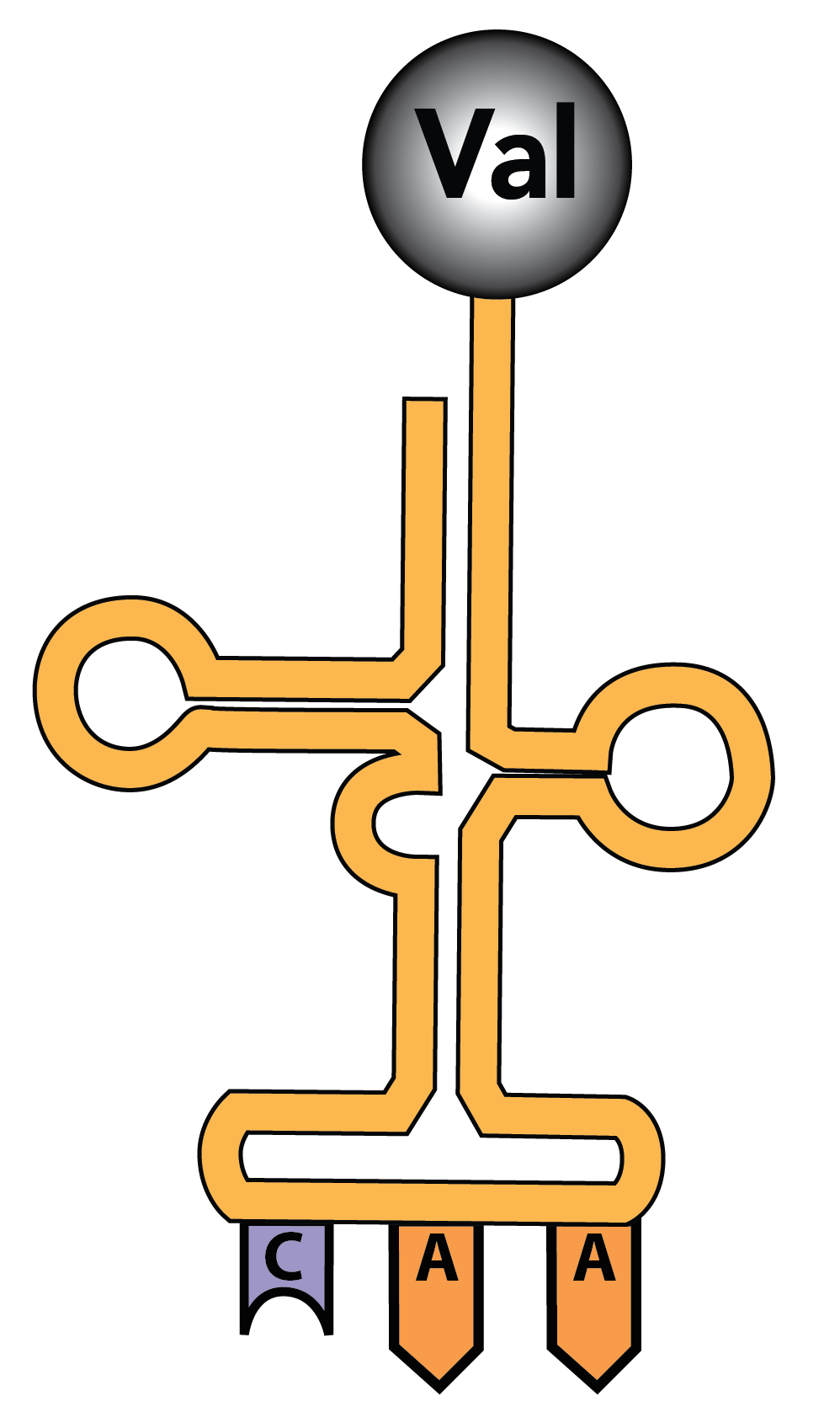
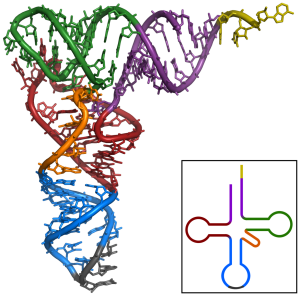
tRNAs are also RNA polymers. They’re generally between 75 and 90 RNA nucleotides long. But unlike mRNAs, which are linear, hydrogen bonding between nucleotides within a tRNA causes it to fold up. The resulting shape is often represented as a type of cloverleaf, as shown on left. A more realistic model (showing some of the base pairing between complementary nucleotides) is shown at right.
On the bottom of the tRNA is an anti-codon: 3 RNA nucleotides that complement the codons in RNA. In other words, for a codon that reads “AAA,” the corresponding anti-codon would be “UUU.”
The top of the tRNA has an amino acid binding site.
There are about 45 distinct tRNAs. Each one has a distinct anti-codon. Since there are only 20 amino acids, several of the tRNAs carry the same amino acid (which is the basis for the fact that many codons are synonymous, coding for the same amino acid).
6. Ribosomes are general-purpose protein factories

Ribosomes are made of ribosomal RNA (rRNA), along with dozens of proteins.
In terms of function, ribosomes are protein factories capable of reading mRNA instructions and, with the help of tRNAs, assembling any protein the cell needs to make.
In prokaryotic cells, ribosomes are found floating freely in the cytoplasm. In eukaryotic cells, they can be in the cytoplasm, or attached to the endoplasmic reticulum (creating the rough E.R.). Chloroplasts and mitochondria also have their own ribosomes, a remnant of their evolutionary origins as free-living bacterial cells.
The ribosome is made of two subunits. These subunits attach during the process of protein  synthesis, then detach after the process is finished. In the image above the small subunit is shown in blue, and the large subunit in red. RNA is shown in dark blue and dark red. The lighter shades of blue and red represent proteins.
synthesis, then detach after the process is finished. In the image above the small subunit is shown in blue, and the large subunit in red. RNA is shown in dark blue and dark red. The lighter shades of blue and red represent proteins.
In the explanation of the protein synthesis that follows, we’re going to use the image on the right. “E”, “P,” and “A” are binding sites, as I’ll explain below.
7. An overview of translation
During translation, ribosomes “read” the mRNA, translating the sequence of codons in the mRNA into a sequence of amino acids in a protein.
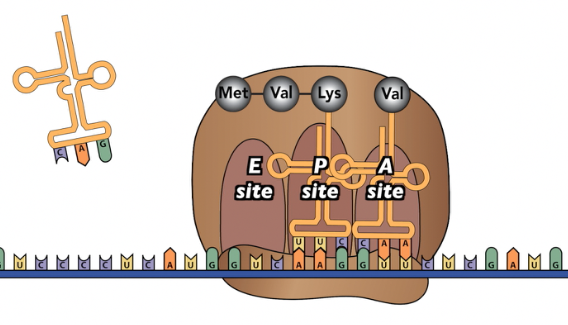
The diagram above shows translation in progress. You’ll watch an animation of this process in a moment, but, for now, notice these key aspects of the process.
- The ribosome is wrapped around the mRNA in a way that exposes the mRNA codons to the cytoplasm.
- The tRNA in the “P” site is holding on to the growing polypeptide, which, in this diagram, consists of three amino acids.
- The tRNA in the “A” site has just entered the ribosome. It’s temporarily held in place by hydrogen bonds between the tRNA’s anticodon and the mRNA’s codon. Imagine that before this tRNA became temporarily stuck, dozens of other tRNAs might have bumped into the “A” site. But because their anti-codon didn’t complement the mRNA codon, each one bounced away.
- What’s the next move? With the correct tRNA in place, the ribosome acts like an enzyme, and binds the amino acid in the “A” site to the polypeptide in the “P” site.
Here’s a summary of the three ribosomal binding sites
- The “E” site is the exit site. After a tRNA has “donated” its amino acid to the growing polypeptide, it moves to the E site, and then leaves the ribosome.
- The “P” site is where the ribosome holds onto the growing protein. It’s formally known as the peptidyl-tRNA site.
- The “A” site is where new tRNAs enter the ribosome. It’s formal name is the “amino-acyl tRNA site”
8. Protein Synthesis Music Video
Pretty much everything you need to know about protein synthesis is found in my protein synthesis music video. Strap yourself in, because my music partner Max Cowan gives this a heavy metal sound. If you’re in a classroom or a computer lab with other students within earshot, please use your headphones/earbuds.
9. Protein Synthesis: Interactive Lyrics
Warning! It takes me about 7 minutes to complete this quiz…Give yourself plenty of time. If you don’t finish you can come back and do only the questions you haven’t done; look for the option “New” after you click “Start quiz”.
[qwiz style = “border: 3px solid black;” dataset_intro=”true” random=”false” use_dataset=”SMV_protein_synthesis_interactive_lyrics2″ qrecord_id=”sciencemusicvideosMeister1961-Protein Synthesis Interactive Lyrics (HS)”]
[h] Protein Synthesis: Interactive Lyrics
[i]
[/qwiz]
10. Protein Synthesis/Translation Fill-in-the-blanks quiz
[qwiz qrecord_id=”sciencemusicvideosMeister1961-Protein Synthesis Fill in the Blanks (HS)”]
[h]Protein Synthesis fill-in-the-blanks quiz
[i]
[q xx=”2″ json=”true” dataset_id=”Protein_synthesis_FC-DS,v2|1ee60808af3f36″ question_number=”1″]The diagram below represents a(n) [hangman].
[c]dFJOQQ==[Qq]
[q xx=”2″ json=”true” dataset_id=”Protein_synthesis_FC-DS,v2|1ee59f42982b36″ question_number=”3″]In the diagram below, 1 represents a(n) [hangman] acid.
[c]YW1pbm8=
Cg==Cg==[Qq][q xx=”2″ json=”true” dataset_id=”Protein_synthesis_FC-DS,v2|1ee570b1aa5b36″ question_number=”4″]In molecular genetics, translation means [hangman] synthesis
[c]cHJvdGVpbg==
Cg==Cg==[Qq][q xx=”2″ json=”true” dataset_id=”Protein_synthesis_FC-DS,v2|1ee53b2498df36″ question_number=”5″]The diagram below represents a(n) [hangman].
[c]dFJOQQ==
Cg==Cg==[Qq][q xx=”2″ json=”true” dataset_id=”Protein_synthesis_FC-DS,v2|1ee48a31112f36″ question_number=”8″]Review: Making DNA from DNA is also known as DNA [hangman].
[c]cmVwbGljYXRpb24=[Qq]
[q xx=”2″ json=”true” dataset_id=”Protein_synthesis_FC-DS,v2|1ee48a31112f36″ question_number=”8″]Review: Making RNA from DNA is also known as [hangman].
[c]dHJhbnNjcmlwdGlvbg==[Qq]
[q xx=”2″ json=”true” dataset_id=”Protein_synthesis_FC-DS,v2|1ee4261311e336″ question_number=”10″]The diagram below represents [hangman].
[c]bVJOQQ==[Qq]
[q xx=”2″ json=”true” dataset_id=”Protein_synthesis_FC-DS,v2|1ee3bd4cfacf36″ question_number=”12″]In the diagram below, the arrow is pointing to a [hangman] bond?
[c]IA==cGVwdGlkZQ==
Cg==[Qq][q xx=”2″ json=”true” dataset_id=”Protein_synthesis_FC-DS,v2|1ee38ebc0cff36″ question_number=”13″]Ribosomes are made of
[[hangman] and protein
[c]IA==clJOQQ==[Qq]
[q xx=”2″ json=”true” dataset_id=”Protein_synthesis_FC-DS,v2|1ee297ef209736″ question_number=”18″]tRNAs carry amino acids to a [hangman].
[c]IA==cmlib3NvbWU=
Cg==[Qq][q xx=”2″ json=”true” dataset_id=”Protein_synthesis_FC-DS,v2|1ee1cd5f161b36″ question_number=”22″]If cells could read, then you could say that mRNA is read by a [hangman].
[c]cmlib3NvbWU=[Qq]
[q xx=”2″ json=”true” dataset_id=”Protein_synthesis_FC-DS,v2|1ee197d2049f36″ question_number=”23″]In mRNA, [hangman]. RNA nucleotides code for one amino acid (hint: spell out a number)
[c]IA==dGhyZWU=[Qq]
[q xx=”2″ json=”true” dataset_id=”Protein_synthesis_FC-DS,v2|1ee12f0bed8b36″ question_number=”25″]In the diagram below, 2 represents a(n) [hangman].
[c]wqBhbnRpY29kb24=
Cg==[Qq][q xx=”2″ json=”true” dataset_id=”Protein_synthesis_FC-DS,v2|1ee09c5d006f36″ question_number=”27″]If a protein was made of 20 amino acids, it would take [hangman] RNA nucleotides to code for it. Hint: spell out a number
[c]c2l4dHk=
Cg==Cg==[Qq][q xx=”2″ json=”true” dataset_id=”Protein_synthesis_FC-DS,v2|1ee066cfeef336″ question_number=”28″]Three bases in mRNA that correspond to one amino acid are called a(n) [hangman].
[c]IA==Y29kb24=Lg==[Qq]
[x]
If you want more practice, please press the restart button below.
[restart]
[/qwiz]
11. Protein Synthesis/Translation Quiz
[qwiz qrecord_id=”sciencemusicvideosMeister1961-Protein Synthesis, Translation Quiz”]
[h]Protein Synthesis/Translation Quiz
[i]
[q xx=”2″ json=”true” labels = “top” dataset_id=”Protein_synth_MC, HM, ID (AP-DS)|14f1c826d059c9″ question_number=”1″]
[l]amino acid
[fx] No. Please try again.
[f*] Great!
[l]anticodon
[fx] No, that’s not correct. Please try again.
[f*] Great!
[l]mRNA
[fx] No. Please try again.
[f*] Good!
[l]large ribosomal subunit
[fx] No, that’s not correct. Please try again.
[f*] Great!
[l]small ribosomal subunit
[fx] No. Please try again.
[f*] Correct!
[l]polypeptide
[fx] No, that’s not correct. Please try again.
[f*] Excellent!
[l]tRNA
[fx] No. Please try again.
[f*] Good!
[q xx=”2″ json=”true” labels = “top” dataset_id=”Protein_synth_MC, HM, ID (AP-DS)|14f0cf05d80dc9″ question_number=”2″]
[l]mRNA
[fx] No. Please try again.
[f*] Correct!
[l]ribosome
[fx] No. Please try again.
[f*] Excellent!
[l]polypeptide chain
[fx] No. Please try again.
[f*] Great!
[q xx=”2″ json=”true” labels = “top” dataset_id=”Protein_synth_MC, HM, ID (AP-DS)|14f01bbe4479c9″ question_number=”3″]Note that one of the labels below is not connected with a number.
[l]amino acid
[fx] No. Please try again.
[f*] Correct!
[l]anti-codon
[fx] No. Please try again.
[f*] Correct!
[l]mRNA
[fx] No. Please try again.
[f*] Great!
[l]nucleus
[fx] No. Please try again.
[f*] Great!
[l]protein
[fx] No. Please try again.
[f*] Excellent!
[l]ribosome
[fx] No, that’s not correct. Please try again.
[f*] Correct!
[l]RNA transcript
[fx] No, that’s not correct. Please try again.
[f*] Excellent!
[l]tRNA
[fx] No. Please try again.
[f*] Correct!
[q xx=”2″ json=”true” dataset_id=”Protein_synth_MC, HM, ID (AP-DS)|14e18523c3e9c9″ question_number=”36″]After the small subunit of the ribosome reaches the start codon AUG, what happens next?
[c]QSB0Uk5BIHdpdGjCoGFudGljb2RvbiBBVUcgZm9ybXMgYSBoeWRyb2dlbiBib25kwqB3aXRoIHRoZSBzdGFydCBjb2RvbiBBVUc=[Qq]
[c]QSB0Uk5BIHdpdGggYW50aWNvZG9uIFVBQyBmb3JtcyBhIGh5ZH JvZ2VuIGJvbmTCoHdpdGggdGhlIHN0YXJ0IGNvZG9uIEFVRw==[Qq]
[c]QcKgdFJOQSB3aXRoIGFudGljb2RvbiBVQUMgZm9ybXMgYSBwZXB0aWRlIGJvbmQgd2l0aCB0aGUgc3RhcnQgY29kb24gQVVHLg==[Qq]
[f]Tm8uwqBGb3IgdGhlIHRSTkEgdG8gYmluZCB3aXRoIHRoZSBzdGFydCBjb2RvbiBBVUcsIGl0IG5lZWRzIHRvIGhhdmUgYW4gYW50aWNvZG9uIHRoYXQmIzgyMTc7cyBjb21wbGVtZW50YXJ5IHRvIEFVRywgbm90IGlkZW50aWNhbCB0byBpdC4gV2hhdCYjODIxNztzIG5lZWRlZCBpcyBzaG93biBiZWxvdy4=
Cg==[Qq]
[f]WWVzLsKgRm9yIHRoZSB0Uk5BIHRvIGJpbmQgd2l0aCB0aGUgc3RhcnQgY29kb24gQVVHLCBpdCBuZWVkcyB0byBoYXZlIGFuIGFudGljb2RvbiB0aGF0JiM4MjE3O3MgY29tcGxlbWVudGFyeSB0byBBVUcuIFRoYXQgYW50aWNvZG9uIGlzIFVBQywgYXMgc2hvd24gYmVsb3cu
Cg==[Qq]
[f]Tm8uIFRoZSBib25kcyBiZXR3ZWVuIGFudGljb2RvbiBhbmQgY29kb24gYXJlIGh5ZHJvZ2VuIGJvbmRzLiBQZXB0aWRlIGJvbmRzIG9ubHkgZm9ybSBiZXR3ZWVuIGFkamFjZW50IGFtaW5vIGFjaWRzIGluIHBvbHlwZXB0aWRlcy7CoA==
Cg==[Qq][q xx=”2″ json=”true” dataset_id=”Protein_synth_MC, HM, ID (AP-DS)|14e03134fbe1c9″ question_number=”39″]Which group of organic compounds includes enzymes?
[c]Y2FyYm9oeWRyYXRlcw==[Qq]
[c]cHJvdG VpbnM=[Qq]
[c]bGlwaWRz[Qq]
[f]Tm8uIEVuenltZXMgYXJlIG5ldmVyIGNhcmJvaHlkcmF0ZXMuIEhlcmXigJlzIGEgaGludDogZW56eW1lcyBhcmUgYnVpbHQgb3V0IG9mIGFtaW5vIGFjaWRzLg==[Qq]
[f]WWVzLiBBbG1vc3QgYWxsIGVuenltZXMgYXJlIHByb3RlaW5zLg==[Qq]
[f]Tm8uIEVuenltZXMgYXJlIG5ldmVyIGxpcGlkcy4gSGVyZeKAmXMgYSBoaW50OiBlbnp5bWVzIGFyZSBidWlsdCBvdXQgb2YgYW1pbm8gYWNpZHMu
Cg==Cg==[Qq][q xx=”2″ json=”true” dataset_id=”Protein_synth_MC, HM, ID (AP-DS)|14dfb1266de5c9″ question_number=”40″]After the small subunit of the ribosome binds with the leading edge of the mRNA, what happens next?
[c]QSB0Uk5BIGJpbmRzIHdpdGggdGhlIGZpcnN0IHNldCBvZiAzIGJhc2VzIG9uIHRoZSBtUk5B[Qq]
[c]VGhlIGxhcmdlIHN1YnVuaXQgb2YgdGhlIHJpYm9zb21lIGJpbmRzIHdpdGggdGhlIHNtYWxsIHN1YnVuaXQu[Qq]
[c]QSBwZXB0aWRlIGJvbmQgZm9ybXMgYmV0d2VlbiB0aGUgc21hbGwgc3VidW5pdCBvZiB0aGUgcmlib3NvbWUgYW5kIHRoZSBtUk5B[Qq]
[c]VGhlIHNtYWxsIHN1YnVuaXQgb2YgdGhlIHJpYm9zb21lIHNsaWRlcyBhbG9uZyB0 aGUgbVJOQSB1bnRpbCBpdCByZWFjaGVzIHRoZSBzdGFydCBjb2RvbiwgQVVHLg==[Qq]
[f]Tm8uIHRSTkFzIHdpbGwgb25seSBzdGFydCBiaW5kaW5nIG9uY2UgdGhlIHJpYm9zb21lIHJlYWNoZXMgdGhlIHN0YXJ0IGNvZG9uIEFVRy4gSW4gb3RoZXIgd29yZHMsIHdoYXQmIzgyMTc7cyBiZWxvdyBoYXMgdG8gaGFwcGVuIGZpcnN0Lg==
Cg==[Qq]
[f]Tm8uwqBUaGUgbGFyZ2Ugc3VidW5pdCB3aWxsIG9ubHkgYmluZCBvbmNlIHRoZSBmaXJzdCB0Uk5BIGlzIGluIHBsYWNlLg==
Cg==And that won’t happen until the small subunit reaches the start codon, AUG.
[f]Tm8uIFRoZSBtYWluIHByb2JsZW0gd2l0aCB0aGlzIHJlc3BvbnNlIGlzIHRoYXQgcGVwdGlkZSBib25kc8Kgb25seSBmb3JtIGJldHdlZW4gYWRqYWNlbnQgYW1pbm8gYWNpZHMgaW4gYSBwb2x5cGVwdGlkZS4gVGhlIG5leHQgc3RlcCBpcyBmb3IgdGhlIHNtYWxsIHN1YnVuaXQgb2YgdGhlIHJpYm9zb21lIHRvIHNsaWRlIGFsb25nIHRvIGEgc3BlY2lmaWMgcGxhY2Ugb24gdGhlIG1STkEgdGhhdCBzdGFydHMgdGhlIHByb2JsZW0u[Qq]
[f]WWVzLsKgQWZ0ZXIgYmluZGluZyB3aXRoIHRoZSBsZWFkaW5nIGVkZ2Ugb2YgdGhlIG1STkEsIHRoZSBzbWFsbCBzdWJ1bml0IG9mIHRoZSByaWJvc29tZSBzbGlkZXMgYWxvbmcgdGhlIG1STkEgdW50aWwgaXQgcmVhY2hlcyB0aGUgc3RhcnQgY29kb24sIEFVRy4=
Cg==Cg==[Qq]
[q xx=”2″ json=”true” dataset_id=”Protein_synth_MC, HM, ID (AP-DS)|14de92c4b759c9″ question_number=”42″]The function of tRNA molecules is to
[c]YnJpbmcgYW1pbm8gYWNpZHMgdG8g bVJOQXMgYXQgcmlib3NvbWVzLg==[Qq]
[c]YnJpbmcgYW1pbm8gYWNpZHMgdG8gRE5BIGluIHRoZSBudWNsZXVzLg==[Qq]
[c]c3ludGhlc2l6ZSBtb3JlIHRyYW5zZmVyIFJOQSBtb2xlY3VsZXMu[Qq]
[c]cHJvdmlkZSBhIHRlbXBsYXRlIGZvciB0aGUgc3ludGhlc2lzIG9mIG1STkEu[Qq]
[f]WWVzLiBUaGUgZnVuY3Rpb24gb2YgdFJOQXMgaXMgdG8gYnJpbmcgYW1pbm8gYWNpZHMgdG8gbVJOQSBhdCByaWJvc29tZXMu[Qq]
[f]Tm8uIHRSTkFzIGFyZSBpbnZvbHZlZCBpbiBwcm90ZWluIHN5bnRoZXNpcy4gV2hlcmUgaXMgdGhhdCBoYXBwZW5pbmc/[Qq]
[f]Tm8uIFN5bnRoZXNpcyBvZiB0Uk5BIGhhcHBlbnMgZHVyaW5nIHRyYW5zY3JpcHRpb24sIGFuZCBpdOKAmXMgY2FycmllZCBvdXQgYnkgUk5BIHBvbHltZXJhc2UgKGFsb25nIHdpdGggYSB0ZWFtIG9mIG90aGVyIGVuenltZXMgYW5kIHByb3RlaW5zKS4gdFJOQXMgYXJlIGludm9sdmVkIGluIHByb3RlaW4gc3ludGhlc2lzLiBXaGVyZSBpcyB0aGF0IGhhcHBlbmluZz8=[Qq]
[f]Tm8uIEROQSBwcm92aWRlcyB0aGUgdGVtcGxhdGUgZm9yIHN5bnRoZXNpcyBvZiBtUk5BLiB0Uk5BcyBhcmUgaW52b2x2ZWQgaW4gcHJvdGVpbiBzeW50aGVzaXMuIFdoZXJlIGlzIHRoYXQgaGFwcGVuaW5nPw==
Cg==Cg==[Qq][q xx=”2″ json=”true” dataset_id=”Protein_synth_MC, HM, ID (AP-DS)|14dda79c0665c9″ question_number=”44″]What’s the first thing that happens during the initiation of protein synthesis?
[c]QSB0Uk5BIGJpbmRzIHdpdGggdGhlIHNtYWxsIHN1YnVuaXQgb2YgdGhlIHJpYm9zb21lLg==[Qq]
[c]VGhlIHNtYWxsIHN1YnVuaXQgb2YgdGhlIHJpYm9zb21lIGJpbm RzIHdpdGggdGhlIG1STkEmIzgyMTc7cyBsZWFkaW5nIGVkZ2Uu[Qq]
[c]VGhlIGxhcmdlIHN1YnVuaXQgb2YgdGhlIHJpYm9zb21lIGJpbmRzIHdpdGggdGhlIHNtYWxsIHN1YnVuaXQu[Qq]
[c]VGhlIGxhcmdlIHN1YnVuaXQgb2YgdGhlIHJpYm9zb21lIGJpbmRzIHdpdGggdGhlwqBzdGFydCBjb2Rvbg==[Qq]
[f]Tm8uQmVmb3JlIHRoaXMgaGFwcGVucywgdGhlIHNtYWxsIHN1YnVuaXQgbmVlZHMgdG8gYmluZCB3aXRoIHRoZSBtUk5BLg==
Cg==[Qq]
[f]WWVzLiBUcmFuc2xhdGlvbiBiZWdpbnMgd2hlbiB0aGUgc21hbGwgc3VidW5pdCBvZiB0aGUgcmlib3NvbWUgYmluZHMgd2l0aCB0aGUgbVJOQSYjODIxNztzIGxlYWRpbmcgZWRnZS4=
Cg==[Qq]
[f]Tm8uwqBUaGUgbGFyZ2Ugc3VidW5pdCBvZiB0aGUgcmlib3NvbWUgY2FuIG9ubHkgYmluZCB3aXRoIHRoZSBzbWFsbCBzdWJ1bml0IGFmdGVyIHRoZSBzbWFsbCBzdWJ1bml0IGJpbmRzIHdpdGggdGhlIG1STkEsIGFuZCB0aGUgZmlyc3QgdFJOQSBiaW5kcy4=
Cg==Cg==[Qq]Before that, the small subunit has to bind with the leading edge of the mRNA.
[f]Tm8uIFRoZSBsYXJnZSBzdWJ1bml0IG9ubHkgYmluZHMgd2l0aCB0aGUgc21hbGwgc3VidW5pdCBhZnRlciB0aGUgc21hbGwgc3VidW5pdCBoYXMgcmVhY2hlZCB0aGUgc3RhcnQgY29kb24gQVVHLCBhbmQgdGhlIGZpcnN0IHRSTkEgYmluZHMu
Cg==Cg==[Qq]
[q xx=”2″ json=”true” dataset_id=”Protein_synth_MC, HM, ID (AP-DS)|14dd3331b3ddc9″ question_number=”45″]During protein synthesis, what attaches to a particular amino acid molecule and positions it on a ribosome?
[c]dFJO QS4=[Qq]
[c]bVJOQS4=[Qq]
[c]RE5BLg==[Qq]
[c]clJOQQ==[Qq]
[f]WWVzLiBEdXJpbmcgcHJvdGVpbiBzeW50aGVzaXMsIHRSTkEgYXR0YWNoZXMgdG8gYSBzcGVjaWZpYyBhbWlubyBhY2lkIGFuZCBicmluZ3MgaXQgdG8gdGhlIHJpYm9zb21lLg==[Qq]
[f]Tm8uIG1STkEgaXMgdGhlIGNvZGVkIG1lc3NhZ2UgdGhhdOKAmXMgdHJhbnNsYXRlZCBpbnRvIHByb3RlaW4gYXQgcmlib3NvbWVzLiBXaGljaCBraW5kIG9mIFJOQSBicmluZ3MgdGhlIGFtaW5vIGFjaWRzIHRvIHRoZSByaWJvc29tZT8=[Qq]
[f]Tm8uIFdoaWxlIEROQSB1bHRpbWF0ZWx5IHByb3ZpZGVzIHRoZSByZWNpcGUgZm9yIG1ha2luZyBwcm90ZWlucywgaXTigJlzIG5vdCBpbnZvbHZlZCBpbiBicmluZ2luZyBhbWlubyBhY2lkcyB0byB0aGUgcmlib3NvbWUuIFRoYXQgcm9sZSBpcyBwbGF5ZWQgYnkgb25lIG9mIHRoZSBSTkFzLiBXaGljaCBvbmU/[Qq]
[f]Tm8uIHJSTkEsIGFsb25nIHdpdGggcHJvdGVpbiwgbWFrZXMgdXAgdGhlIHJpYm9zb21lLiBXaGljaCBraW5kIG9mIFJOQSBicmluZ3MgdGhlIGFtaW5vIGFjaWRzIHRvIHRoZSByaWJvc29tZT8=
Cg==Cg==[Qq][q xx=”2″ json=”true” dataset_id=”Protein_synth_MC, HM, ID (AP-DS)|14dcc11b6d39c9″ question_number=”46″]Each protein in an organism is coded for by an individual
[c]cmlib3NvbWU=[Qq]
[c]Y2hyb21vc29tZS4=[Qq]
[c]bnVjbGVvdGlkZQ==[Qq]
[c]Z2Vu ZQ==[Qq]
[f]Tm8uIFJpYm9zb21lcyBwbGF5IGEga2V5IHJvbGUgaW4gc3ludGhlc2l6aW5nIHByb3RlaW5zLCBidXQgdGhleeKAmXJlIG5vdCB0aGUgY29kZS4gV2hhdCBkbyB3ZSBjYWxsIGEgc2VxdWVuY2Ugb2YgbnVjbGVvdGlkZXMgdGhhdCBjb2RlcyBmb3IgYSBzcGVjaWZpYyBwcm90ZWluPyBIZXJl4oCZcyBhIGhpbnQ6IGl04oCZcyBzb21ldGhpbmcgeW91IGluaGVyaXQu[Qq]
[f]Tm8uIENocm9tb3NvbWVzIGFyZSB0aGUgZW5vcm1vdXMgbW9sZWN1bGVzIG9mIEROQSB0aGF0IHN0b3JlIGdlbmV0aWMgaW5mb3JtYXRpb24gaW4gY2VsbHMuIFdoYXQgZG8gd2UgY2FsbCBhIHNlcXVlbmNlIG9mIG51Y2xlb3RpZGVzIHRoYXQgY29kZXMgZm9yIGEgc3BlY2lmaWMgcHJvdGVpbj8gSGVyZeKAmXMgYSBoaW50OiBpdOKAmXMgc29tZXRoaW5nIHlvdSBpbmhlcml0Lg==[Qq]
[f]Tm8uIE51Y2xlb3RpZGVzIGFyZSB0aGUgbW9ub21lcnMgb2YgbnVjbGVpYyBhY2lkcy4gQ29tYmluYXRpb25zIG9mIG51Y2xlb3RpZGVzIGFyZSB3aGF0IGNvZGUgZm9yIHByb3RlaW5zLiBXaGF0IGRvIHdlIGNhbGwgYSBzZXF1ZW5jZSBvZiBudWNsZW90aWRlcyB0aGF0IGNvZGVzIGZvciBhIHNwZWNpZmljIHByb3RlaW4/IEhlcmXigJlzIGEgaGludDogaXTigJlzIHNvbWV0aGluZyB5b3UgaW5oZXJpdC4=[Qq]
[f]WWVzLiBFYWNoIHByb3RlaW4gaXMgY29kZWQgZm9yIGJ5IGFuIGluZGl2aWR1YWwgZ2VuZS4=
Cg==Cg==[Qq][q xx=”2″ json=”true” dataset_id=”Protein_synth_MC, HM, ID (AP-DS)|14dbdceedff1c9″ question_number=”48″]Amino acids are required in the human diet principally for the synthesis of
[c]cHJvdG VpbnMu[Qq]
[c]c3VnYXJzLg==[Qq]
[c]c3RhcmNoZXMu[Qq]
[c]bGlwaWRzLg==[Qq]
[f]WWVzLiBXZSBuZWVkIGFtaW5vIGFjaWRzIGJlY2F1c2UgdGhleeKAmXJlIHRoZSBtb25vbWVycyAoYnVpbGRpbmcgYmxvY2tzKSBvZiBwcm90ZWlucy4=[Qq]
[f]Tm8uIFN1Z2FycyBhcmUgcmVxdWlyZWQgaW4gb3VyIGRpZXRzIHByaW5jaXBhbGx5IGZvciBlbmVyZ3kuIFdoYXQgYXJlIGFtaW5vIGFjaWRzIHRoZSBtb25vbWVycyAoYnVpbGRpbmcgYmxvY2tzKSBvZj8=[Qq]
[f]Tm8uIFdlIGRpZ2VzdCBzdGFyY2ggZG93biB0byBzdWdhcnMsIHdoaWNoIHdlIG1vc3RseSByZXF1aXJlIGZvciBlbmVyZ3kuIFdoYXQgYXJlIGFtaW5vIGFjaWRzIHRoZSBtb25vbWVycyAoYnVpbGRpbmcgYmxvY2tzKSBvZj8=[Qq]
[f]Tm8uIFRoZSBsaXBpZHMgaW4gb3VyIGRpZXQgKG1vc3RseSBmYXRzIGFuZCBvaWxzKSBhcmUgcHJpbWFyaWx5IHJlcXVpcmVkIGZvciBlbmVyZ3kuIFdoYXQgYXJlIGFtaW5vIGFjaWRzIHRoZSBtb25vbWVycyAoYnVpbGRpbmcgYmxvY2tzKSBvZj8=
Cg==Cg==[Qq][q xx=”2″ json=”true” dataset_id=”Protein_synth_MC, HM, ID (AP-DS)|14db63dc75a1c9″ question_number=”49″]After the amino acid that a tRNA brings to a ribosome has been attached to a polypeptide, what happens to the tRNA?
[c]SXQgZm9ybXMgYSBzdWdhci1waG9zcGhhdGUgYm9uZCB3aXRoIHRoZSBuZXh0IHRSTkE=[Qq]
[c]SXQgaXMgZGlnZXN0ZWQgYnkgdGhlIHJpYm9zb21lIHNvIHRoYXQgaXRzIG51Y2xlb3RpZGVzIGNhbiBiZSB1c2VkIHRvIGJ1aWxkIG5ldyBSTkE=[Qq]
[c]SXQgZGV0YWNoZXMgZnJvbSB0aGUgcmlib3NvbWUg YW5kIG1vdmVzIGludG8gdGhlIGN5dG9wbGFzbS4=[Qq]
[f]Tm8uVGhlcmUgYXJlIHR3byBwcm9ibGVtcyB3aXRoIHRoaXMgYW5zd2VyLiAxKSB0Uk5BcyBkb24mIzgyMTc7dCBib25kIHdpdGggb25lIGFub3RoZXIuIDIpwqBTdWdhciBwaG9zcGhhdGUgYm9uZHMgYXJlIHRoZSBib25kcyBiZXR3ZWVuIGFkamFjZW50IG51Y2xlb3RpZGVzIGluIGEgbnVjbGVpYyBhY2lkLg==[Qq]
[f]Tm8uIFJpYm9zb21lcyBkbyBoYXZlIHNvbWUgZW56eW1hdGljIHBvd2VycyAodGhleSBjYW4gY2F0YWx5emUgcGVwdGlkZSBib25kcyBiZXR3ZWVuIGFtaW5vIGFjaWRzKSwgYnV0IHRoZXkgZG9uJiM4MjE3O3QgZGlnZXN0IHRSTkFzLg==[Qq]
[f]WWVzLiBBZnRlciBkcm9wcGluZyBvZmYgdGhlaXIgYW1pbm8gYWNpZHMsIHRSTkFzIGRldGFjaCBmcm9tIHRoZSByaWJvc29tZS4=
Cg==Cg==[Qq][q xx=”2″ json=”true” dataset_id=”Protein_synth_MC, HM, ID (AP-DS)|14da78b3c4adc9″ question_number=”51″]What is the function of DNA molecules in the synthesis of proteins?
[c]RE5BIG1vbGVjdWxlcyBjYXRhbHl6ZSB0aGUgZm9ybWF0aW9uIG9mIHBlcHRpZGUgYm9uZHMu[Qq]
[c]RE5BIG1vbGVjdWxlcyBkZXRlcm1pbmUgdGhlIHNlcXVl bmNlIG9mIGFtaW5vIGFjaWRzIGluIGEgcHJvdGVpbi4=[Qq]
[c]RE5BIG1vbGVjdWxlcyB0cmFuc2ZlciBhbWlubyBhY2lkcyBmcm9tIHRoZSBjeXRvcGxhc20gdG8gdGhlIG51Y2xldXMu[Qq]
[f]Tm8uIENhdGFseXppbmcgcGVwdGlkZSBib25kcyBpcyB0aGUgam9iIG9mIHRoZSByaWJvc29tZS4gRE5B4oCZcyByb2xlIGlzIG11Y2ggbW9yZSBpbmZvcm1hdGlvbmFsPw==[Qq]
[f]WWVzLiBETkEgdWx0aW1hdGVseSBkZXRlcm1pbmVzIHRoZSBzZXF1ZW5jZSBvZiBhbWlubyBhY2lkcyBpbiBhIHByb3RlaW4u[Qq]
[f]Tm8uIFRoZSBtYWpvciBwcm9ibGVtIHdpdGggdGhpcyBjaG9pY2UgaXMgdGhhdCBhbWlubyBhY2lkcyBkbyBnZXQgdHJhbnNmZXJyZWQsIGJ1dCBub3QgdG8gdGhlIG51Y2xldXMuIFRoaW5rIG9mIHRoZSBjZW50cmFsIGRvZ21hIG9mIG1vbGVjdWxhciBnZW5ldGljcyAoRE5BIG1ha2VzIFJOQSBtYWtlcyBwcm90ZWluKSBhbmQgeW914oCZbGwgaGF2ZSB5b3VyIGFuc3dlci4=
Cg==Cg==[Qq][q xx=”2″ json=”true” dataset_id=”Protein_synth_MC, HM, ID (AP-DS)|14da01f56641c9″ question_number=”52″]The following sequence-AUGCGAUUAAUAUUGAAUUAG-indicates a(n)
[c]RE5BIG1vbGVjdWxlLg==[Qq]
[c]RE5BIG1vbGVjdWxlIHdpdGggYSBtdXRhdGlvbi4=[Qq]
[c]Uk5BIG1vbG VjdWxlLg==[Qq]
[c]YW1pbm8gYWNpZCBzZXF1ZW5jZS4=[Qq]
[f]Tm8uIEROQSBtb2xlY3VsZXMgYXJlIGNvbXBvc2VkIG9mIEROQSBudWNsZW90aWRlcyB3aXRoIHRoZSBuaXRyb2dlbm91cyBiYXNlcyBBLCBULCBDLCBhbmQgRy4gV2hpY2ggbnVjbGVpYyBhY2lkIGhhcyB0aGUgbml0cm9nZW5vdXMgYmFzZSBVIChmb3IgdXJhY2lsKT8=[Qq]
[f]Tm8uIEEgbXV0YXRpb24gd291bGQgc3Vic3RpdHV0ZSBvbmUgRE5BIG51Y2xlb3RpZGUgZm9yIGFub3RoZXIsIGJ1dCB0aGUgcmVzdWx0aW5nIEROQSBtb2xlY3VsZSB3b3VsZCBzdGlsbCBiZSBjb21wb3NlZCBvZiB0aGUgbml0cm9nZW5vdXMgYmFzZXMgQSwgVCwgQywgYW5kIEcuIFdoaWNoIG51Y2xlaWMgYWNpZCBoYXMgVT8=[Qq]
[f]WWVzLiBSTkEgaXMgY29tcG9zZWQgb2YgUk5BIG51Y2xlb3RpZGVzIHdpdGggdGhlIG5pdHJvZ2Vub3VzIGJhc2VzIEEsIFUsIEMsIGFuZCBHLg==[Qq]
[f]Tm8uIEFuIGFtaW5vIGFjaWQgc2VxdWVuY2UgaXMgY29tcG9zZWQgb2YgYW1pbm8gYWNpZHMuIEVhY2ggYW1pbm8gYWNpZCBpcyB1c3VhbGx5IHJlcHJlc2VudGVkIGJ5IGEgdGhyZWUgbGV0dGVyIGFiYnJldmlhdGlvbnMsIGFuZCBhIHNlcXVlbmNlIG9mIGFtaW5vIGFjaWRzIHdvdWxkIGxvb2sgbGlrZSBHTFktU0VSLVBIRS1MRVUuIFRoZSBBLCBVLCBDLCBHIHNlcXVlbmNlIHNob3duIGFib3ZlIHJlcHJlc2VudHMgYSBudWNsZWljIGFjaWQuIFdoaWNoIG9uZT8=
Cg==Cg==[Qq][q xx=”2″ json=”true” dataset_id=”Protein_synth_MC, HM, ID (AP-DS)|14d916ccb54dc9″ question_number=”54″]The bonds between codons and anti-codons are
[c]aHlkcm9nZW 4gYm9uZHM=[Qq]
[c]aW9uaWMgYm9uZHM=[Qq]
[c]c3VnYXItcGhvc3BoYXRlIGJvbmRz[Qq]
[c]cGVwdGlkZSBib25kcw==[Qq]
[f]RXhjZWxsZW50LiBUaGUgYm9uZCBiZXR3ZWVuIGEgY29kb24gYW5kIGFudGktY29kb24gaXMgYSBoeWRyb2dlbiBib25kLg==[Qq]
[f]Tm8uwqBJb25pYyBib25kcyBhcmUgYm9uZHMgdGhhdCBvY2N1ciBiZXR3ZWVuIGlvbnMsIGZ1bGx5IGNoYXJnZWQgcGFydGljbGVzLiBUaGUgYm9uZCBiZXR3ZWVuIHNvZGl1bSBhbmQgY2hsb3JpbmUgaW4gdGFibGUgc2FsdCwgTmFDbCBpcyBhbiBpb25pYyBib25kLg==[Qq]
[f]Tm8uIFN1Z2FyLXBob3NwaGF0ZSBib25kcyBhcmUgdGhlIGJvbmRzIHRoYXQgY29ubmVjdCBhZGphY2VudCBudWNsZW90aWRlcyBpbiBudWNsZWljIGFjaWRzLg==[Qq]
[f]Tm8uIFBlcHRpZGUgYm9uZCBpcyB0aGUgbmFtZSBnaXZlbiB0byB0aGUgYm9uZCBiZXR3ZWVuIG9uZSBhbWlubyBhY2lkIGFuZCB0aGUgbmV4dCBpbiBhIHBvbHlwZXB0aWRlLg==
Cg==Cg==[Qq][q xx=”2″ json=”true” dataset_id=”Protein_synth_MC, HM, ID (AP-DS)|14d8a70a7a8dc9″ question_number=”55″]Which of the following molecules, along with proteins, makes up ribosomes?
[c]dFJOQQ==[Qq]
[c]Uk5BIHBvbHltZXJhc2U=[Qq]
[c]clJO QQ==[Qq]
[c]bVJOQQ==[Qq]
[f]Tm8uIHRSTkEgc3RhbmRzIGZvciDigJx0cmFuc2ZlciBSTkEu4oCdIFdoYXQga2luZCBvZiBSTkEgKGFsb25nIHdpdGggcHJvdGVpbikgbWFrZXMgdXAgcmlib3NvbWVzPw==[Qq]
[f]Tm8uIFJOQSBwb2x5bWVyYXNlIGlzIHRoZSBlbnp5bWUgdGhhdCB0cmFuc2NyaWJlcyBSTkEgZnJvbSBETkEuIFdoYXQga2luZCBvZiBSTkEgKGFsb25nIHdpdGggcHJvdGVpbikgbWFrZXMgdXAgcmlib3NvbWVzPw==[Qq]
[f]WWVzLiByUk5BLCBhbG9uZyB3aXRoIHByb3RlaW4sIG1ha2VzIHVwIHJpYm9zb21lcy4=[Qq]
[f]Tm8uIG1STkEgc3RhbmRzIGZvciDigJxtZXNzZW5nZXIgUk5BLuKAnSBXaGF0IGtpbmQgb2YgUk5BIChhbG9uZyB3aXRoIHByb3RlaW4pIG1ha2VzIHVwIHJpYm9zb21lcz8=
Cg==Cg==[Qq][q xx=”2″ json=”true” dataset_id=”Protein_synth_MC, HM, ID (AP-DS)|14d8294ff875c9″ question_number=”56″]Which of the following is not a direct function of DNA?
[c]VHJhbnNmZXIgb2YgZ2VuZXRpYyBpbmZvcm1hdGlvbiBmcm9tIGdlbmVyYXRpb24gdG8gZ2VuZXJhdGlvbi4=[Qq]
[c]U3RvcmFnZSBvZiBnZW5ldGljIGluZm9ybWF0aW9uIHdpdGhpbiB0aGUgY2VsbC4=[Qq]
[c]QWxsb3dpbmcgZm9yIGV4YWN0IGR1cGxpY2F0aW9uIG9mIGl0c2VsZi4=[Qq]
[c]U3ludGhlc2lzIG9mIGFtaW5vIG FjaWRzIGludG8gcHJvdGVpbnMu[Qq]
[f]Tm8uIFRyYW5zZmVycmluZyBnZW5ldGljIGluZm9ybWF0aW9uIGZyb20gb25lIGdlbmVyYXRpb24gdG8gdGhlIG5leHQgaXMgRE5B4oCZcyBkaXJlY3QgZnVuY3Rpb24uIFdoaWNoIGZ1bmN0aW9uIGxpc3RlZCByZXF1aXJlcyB0aGUgcGFydGljaXBhdGlvbiBvZiBSTkEgdG8gZ2V0IHRoZSBqb2IgZG9uZT8=[Qq]
[f]Tm8uIFN0b3JhZ2Ugb2YgZ2VuZXRpYyBpbmZvcm1hdGlvbiBpbiBjZWxscyBpcyBhIGZ1bmN0aW9uIG9mIEROQS4gTm8uIFRyYW5zZmVycmluZyBnZW5ldGljIGluZm9ybWF0aW9uIGZyb20gb25lIGdlbmVyYXRpb24gdG8gdGhlIG5leHQgaXMgRE5B4oCZcyBkaXJlY3QgZnVuY3Rpb24uIFdoaWNoIGZ1bmN0aW9uIGxpc3RlZCByZXF1aXJlcyB0aGUgcGFydGljaXBhdGlvbiBvZiBSTkEgdG8gZ2V0IHRoZSBqb2IgZG9uZT8=[Qq]
[f]Tm8uIEFsbG93aW5nIGZvciBleGFjdCBkdXBsaWNhdGlvbiBvZiBpdHNlbGYgaXMgYnVpbHQgaW50byBETkHigJlzIHN0cnVjdHVyZS4gTm8uIFRyYW5zZmVycmluZyBnZW5ldGljIGluZm9ybWF0aW9uIGZyb20gb25lIGdlbmVyYXRpb24gdG8gdGhlIG5leHQgaXMgRE5B4oCZcyBkaXJlY3QgZnVuY3Rpb24uIFdoaWNoIGZ1bmN0aW9uIGxpc3RlZCByZXF1aXJlcyB0aGUgcGFydGljaXBhdGlvbiBvZiBSTkEgdG8gZ2V0IHRoZSBqb2IgZG9uZT8=[Qq]
[f]WWVzLiBETkHigJlzIHJvbGUgaW4gcHJvdGVpbiBzeW50aGVzaXMgaXMgaW5kaXJlY3QuIFRoZSBtb2xlY3VsZXMgZGlyZWN0bHkgaW52b2x2ZXMgYXJlIGFsbCBSTkFzLg==
Cg==Cg==[Qq][q xx=”2″ json=”true” dataset_id=”Protein_synth_MC, HM, ID (AP-DS)|14d7372b23d5c9″ question_number=”58″]The most accurate name for the bonds connecting the amino acids in a polypeptide is
[c]aHlkcm9nZW4gYm9uZA==[Qq]
[c]aW9uaWMgYm9uZA==[Qq]
[c]c3VnYXItcGhvc3BoYXRlIGJvbmQ=[Qq]
[c]cGVwdGlk ZSBib25k[Qq]
[f]Tm8uwqBIeWRyb2dlbiBib25kcyBhcmUgdGhlIHdlYWsgYm9uZHMgdGhhdCBvY2N1ciBiZXR3ZWVuIHBvbGFyIG1vbGVjdWxlcywgb3IgYmV0d2VlbiBwb2xhciBwYXJ0cyBvZiB0aGUgc2FtZSBtb2xlY3VsZS4gVGhlIGJvbmQgYmV0d2VlbiBhZGVuaW5lIGFuZCB0aHltaW5lIGluIEROQSBpcyBhIGh5ZHJvZ2VuIGJvbmQu[Qq]
[f]Tm8uwqBJb25pYyBib25kcyBhcmUgYm9uZHMgdGhhdCBvY2N1ciBiZXR3ZWVuIGlvbnMsIGZ1bGx5IGNoYXJnZWQgcGFydGljbGVzLiBUaGUgYm9uZCBiZXR3ZWVuIHNvZGl1bSBhbmQgY2hsb3JpbmUgaW4gdGFibGUgc2FsdCwgTmFDbCBpcyBhbiBpb25pYyBib25kLg==[Qq]
[f]Tm8uIFN1Z2FyLXBob3NwaGF0ZSBib25kcyBhcmUgdGhlIGJvbmRzIHRoYXQgY29ubmVjdCBhZGphY2VudCBudWNsZW90aWRlcyBpbiBudWNsZWljIGFjaWRzLg==[Qq]
[f]WWVzLsKgUGVwdGlkZSBib25kIGlzIHRoZSBuYW1lIGdpdmVuIHRvIHRoZSBib25kIGJldHdlZW4gb25lIGFtaW5vIGFjaWQgYW5kIHRoZSBuZXh0IGluIGEgcG9seXBlcHRpZGUu
Cg==Cg==[Qq][q xx=”2″ json=”true” dataset_id=”Protein_synth_MC, HM, ID (AP-DS)|14d649ae66fdc9″ question_number=”60″]The movement of a ribosome from one codon to the next down the length of an mRNA strand is called
[c]dHJhbnNsYXRpb24=[Qq]
[c]dHJhbnNjcmlwdGlvbg==[Qq]
[c]dHJhbnNsb2 NhdGlvbg==[Qq]
[f]Tm8uwqBUcmFuc2xhdGlvbiBpcyB0aGUgbmFtZSBmb3IgdGhlIGVudGlyZSBwcm9jZXNzIG9mIHByb3RlaW4gc3ludGhlc2lzLg==[Qq]
[f]Tm8uwqBUcmFuc2NyaXB0aW9uIGlzIHRoZSBtYWtpbmcgb2bCoFJOQSBmcm9tIGEgRE5BIHRlbXBsYXRlLg==[Qq]
[f]WWVzLiBUcmFuc2xvY2F0aW9uIGlzIHRoZSBtb3ZlbWVudCBvZiBhIHJpYm9zb21lIGRvd24gdGhlIGxlbmd0aCBvZiBhbiBtUk5BIHN0cmFuZC4=
Cg==Cg==[Qq][q xx=”2″ json=”true” dataset_id=”Protein_synth_MC, HM, ID (AP-DS)|14d5d09bfcadc9″ question_number=”61″]mRNA is responsible for
[c]cHJvZHVjdGlvbiBvZiByaWJvc29tZXMu[Qq]
[c]YnJpbmdpbmcgaW5zdHJ1Y3Rpb2 5zIHRvIHRoZSByaWJvc29tZXMu[Qq]
[c]cmVhZGluZyB0aGUgYW1pbm8gYWNpZCBjb2RlIGZyb20gdFJOQS4=[Qq]
[c]dHJhbnNjcmlwdGlvbiBvZiBETkEgaW50byBSTkEu[Qq]
[c]YnJpbmdpbmcgYW1pbm8gYWNpZHMgdG8gdGhlIHJpYm9zb21lcy4=[Qq]
[f]Tm8uIFByb2R1Y3Rpb24gb2Ygcmlib3NvbWVzIGludm9sdmVzIHByb2R1Y2luZyBSTkEgYW5kIHByb3RlaW4uIFByb2R1Y2luZyBSTkEgaXMgYSBmdW5jdGlvbiBvZiBSTkEgcG9seW1lcmFzZS4gUHJvZHVjaW5nIHByb3RlaW4gaW52b2x2ZXMgbVJOQSwgYnV0IGFsc28gdFJOQXMgYW5kIHJpYm9zb21lcy4gbVJOQSBoYXMgYSBrZXkgam9iIGR1cmluZyBwcm90ZWluIHN5bnRoZXNpcy4gV2hhdCBpcyBpdD8=[Qq]
[f]WWVzLiBtUk5B4oCZcyBmdW5jdGlvbiBpcyB0byBicmluZyBpbnN0cnVjdGlvbiB0byB0aGUgcmlib3NvbWVzLg==[Qq]
[f]Tm8uIFRoaXMgY2hvaWNlIGhhcyBzZXZlcmFsIHByb2JsZW1zLiAxKSBUaGUgY29kZSBpcyBmb3IgcHJvdGVpbnMsIG5vdCBhbWlubyBhY2lkcyAodGhlIG1vbm9tZXJzIG9mIHByb3RlaW4pLiAyKSBUaGUgY29kZSBpcyBvbiB0aGUgbVJOQSwgbm90IHRSTkEgKGFuZCB0aGF04oCZcyBhIGhpbnQgdG8gdGhlIGFuc3dlciB3aGVuIHlvdSBzZWUgdGhpcyBxdWVzdGlvbiBsYXRlciku[Qq]
[f]Tm8uIFRoZSBlbnp5bWUgUk5BIHBvbHltZXJhc2UgdHJhbnNjcmliZXMgRE5BIGludG8gUk5BLiBNZXNzZW5nZXIgUk5BIChtUk5BKSBoYXMgYSBrZXkgam9iIGR1cmluZyBwcm90ZWluIHN5bnRoZXNpcy4gV2hhdCBpcyBpdD8=[Qq]
[f]Tm8uIHRSTkEgaXMgdGhlIG1vbGVjdWxlIHRoYXQgYnJpbmdzIGFtaW5vIGFjaWRzIHRvIHRoZSByaWJvc29tZXMuIE1lc3NlbmdlciBSTkEgKG1STkEpIGhhcyBhIGtleSBqb2IgZHVyaW5nIHByb3RlaW4gc3ludGhlc2lzLiBXaGF0IGlzIGl0Pw==
Cg==Cg==[Qq][q xx=”2″ json=”true” dataset_id=”Protein_synth_MC, HM, ID (AP-DS)|14d5508d6eb1c9″ question_number=”62″]Translation is the process in which
[c]RE5BIG1ha2VzIGFuIGV4YWN0IGNvcHkgb2YgaXRzZWxmLg==[Qq]
[c]dGhlIEROQSBzdHJhbmQgdW53aW5kcyBhbmQgdHJhbnNjcmliZXMgaW5mb3JtYXRpb24gdG8gbVJOQS4=[Qq]
[c]aW5mb3JtYXRpb24gaW4gY29kb25zIGlzIHVzZWQgdG 8gYnVpbGQgY2hhaW5zIG9mIGFtaW5vIGFjaWRzLg==[Qq]
[c]Uk5BIGxlYXZlcyB0aGUgbnVjbGV1cyB0aHJvdWdoIG51Y2xlYXIgcG9yZXMu[Qq]
[f]Tm8uIENvcHlpbmcgRE5BIGlzIHJlcGxpY2F0aW9uLiBJbiBtb2xlY3VsYXIgZ2VuZXRpY3MsIHdoYXQgaXMgdHJhbnNsYXRpb24gYSBzeW5vbnltIGZvcj8=[Qq]
[f]Tm8uIFdoZW4gdGhlIEROQSBzdHJhbmQgdW53aW5kcyBhbmQgdHJhbnNjcmliZXMgaW5mb3JtYXRpb24gdG8gbVJOQSwgdGhhdOKAmXMgdHJhbnNjcmlwdGlvbi4gbiBtb2xlY3VsYXIgZ2VuZXRpY3MsIHdoYXQgaXMgdHJhbnNsYXRpb24gYSBzeW5vbnltIGZvcj8=[Qq]
[f]WWVzLiBUcmFuc2xhdGlvbiBpcyB3aGVuIGNlbGxzIHVzZSB0aGUgaW5mb3JtYXRpb24gaW4gUk5BIGNvZG9ucyB0byBidWlsZCBjaGFpbnMgb2YgYW1pbm8gYWNpZHMu[Qq]
[f]Tm8uIFJOQeKAmXMgbW92ZSBpbnRvIHRoZSBjeXRvcGxhc20gaGFwcGVucyBiZWZvcmUgdHJhbnNsYXRpb24gb2NjdXJzLiBXaGF0IGhhcHBlbnMgZHVyaW5nIHRyYW5zbGF0aW9uIGl0c2VsZj8=
Cg==Cg==[Qq][q xx=”2″ json=”true” dataset_id=”Protein_synth_MC, HM, ID (AP-DS)|14d4d9cf1045c9″ question_number=”63″]Three bases on a tRNA that bind with complementary bases on mRNA are referred to as a(n)
[c]Y29kb24u[Qq]
[c]YW50aWNv ZG9uLg==[Qq]
[c]dHJpcGxldC4=[Qq]
[c]cG9seXBlcHRpZGUu[Qq]
[f]Tm8uIEEgY29kb24gaXMgdGhyZWUgYmFzZXMgb24gbVJOQS4gSGVyZeKAmXMgYSBoaW50OiB0aGUgYW5zd2VyIGluY2x1ZGVzIHRoZSB3b3JkIOKAnGNvZG9uLOKAnSBhbmQgdGhlIHByZWZpeCB0aGF0IG1lYW5zIOKAnGFnYWluc3Qu4oCd[Qq]
[f]WWVzLiBUaHJlZSBiYXNlcyBvbiBhIHRSTkEgdGhhdCBiaW5kIHdpdGggY29tcGxlbWVudGFyeSBiYXNlcyBvbiBtUk5BIGFyZSByZWZlcnJlZCB0byBhcyBhbiBhbnRpY29kb24u[Qq]
[f]Tm8uIEEgdHJpcGxldCByZWZlcnMgdG8gYW55IHRocmVlIGNvZGluZyBiYXNlcyBvbiBETkEgb3IgUk5BLiBIZXJl4oCZcyBhIGhpbnQgZm9yIHRoZXNlIHRocmVlIHRSTkEgYmFzZXM6IHRoZSBhbnN3ZXIgaW5jbHVkZXMgdGhlIHdvcmQg4oCcY29kb24s4oCdIGFuZCB0aGUgcHJlZml4IHRoYXQgbWVhbnMg4oCcYWdhaW5zdC7igJ0=[Qq]
[f]Tm8uIEEgcG9seXBlcHRpZGUgaXMgYSBjaGFpbiBvZiBhbWlubyBhY2lkcy4gSGVyZeKAmXMgYSBoaW50IGZvciB0aGVzZSB0aHJlZSB0Uk5BIGJhc2VzOiB0aGUgYW5zd2VyIGluY2x1ZGVzIHRoZSB3b3JkIOKAnGNvZG9uLOKAnSBhbmQgdGhlIHByZWZpeCB0aGF0IG1lYW5zIOKAnGFnYWluc3Qu4oCd
Cg==Cg==[Qq][q xx=”2″ json=”true” dataset_id=”Protein_synth_MC, HM, ID (AP-DS)|14d43b7be7b5c9″ question_number=”64″]A ribosome reaches the stop codon on an mRNA. The next thing that will happen is
[c]dGhlIHRSTkFzIGRldGFjaCBmcm9tIHRoZWlyIGJpbmRpbmcgc2l0ZXMu[Qq]
[c]YSByZWxlYXNlIGZhY3RvciBiaW5kcy B3aXRoIHRoZSBzdG9wIGNvZG9uLg==[Qq]
[c]dGhlIHJpYm9zb21lIGZhbGxzIGFwYXJ0[Qq]
[c]dGhlIHBvbHlwZXB0aWRlIGlzIHJlbGVhc2Vk[Qq]
[f]Tm8uwqBCZWZvcmUgdGhlIHRSTkFzIGRldGFjaCwgc29tZXRoaW5nIGhhcyB0byBiaW5kIHdpdGggdGhlIHN0b3AgY29kb24u[Qq]
[f]WWVzLiBBIHJlbGVhc2UgZmFjdG9yIHdpbGwgYmluZCB3aXRoIHRoZSBzdG9wIGNvZG9uLCBsZWFkaW5nIHRoZSBwb2x5cGVwdGlkZSB0byBkZXRhY2ggYW5kIHRoZSBlbnRpcmUgcmlib3NvbWUgYXNzZW1ibHkgc3RydWN0dXJlIHRvIGZhbGwgYXBhcnQu[Qq]
[f]Tm8uwqBCZWZvcmUgdGhlIHJpYm9zb21lIGZhbGxzIGFwYXJ0LCBzb21ldGhpbmcgaGFzIHRvIGJpbmQgd2l0aCB0aGUgc3RvcCBjb2Rvbi4=[Qq]
[f]Tm8uwqBCZWZvcmUgdGhlIHBvbHlwZXB0aWRlIGlzIHJlbGVhc2VkLCBzb21ldGhpbmcgaGFzIHRvIGJpbmQgd2l0aCB0aGUgc3RvcCBjb2Rvbi4=
Cg==Cg==[Qq][q xx=”2″ json=”true” dataset_id=”Protein_synth_MC, HM, ID (AP-DS)|14cfcb453d15c9″ question_number=”65″]How many nucleotides are required to spell out an amino acid.
[c]b25l[Qq]
[c]dHdv[Qq]
[c]dGhy ZWU=[Qq]
[c]Zm91cg==[Qq]
[f]Tm8uIFRoaXMga2luZCBvZiBxdWVzdGlvbiBpcyBhYm91dCB0aGUgZ2VuZXRpYyBjb2RlLiBUaGVyZSBhcmUgdHdlbnR5IGFtaW5vIGFjaWRzLiBTaW5jZSB0aGVyZSBhcmUgb25seSBmb3VyIG51Y2xlb3RpZGVzLCBoYXZpbmcgb25lIG51Y2xlb3RpZGUgY29kZSBmb3Igb25lIGFtaW5vIGFjaWQgd291bGQgYmUgaW5zdWZmaWNpZW50IGZvciBpbmRpY2F0aW5nIGFsbCAyMCBhbWlubyBhY2lkcy4gV291bGQgY29tYmluYXRpb25zIG9mIHR3byBudWNsZW90aWRlcyB3b3JrPw==[Qq]
[f]Tm8uIFRoaXMga2luZCBvZiBxdWVzdGlvbiBpcyBhYm91dCB0aGUgZ2VuZXRpYyBjb2RlLiBUaGVyZSBhcmUgdHdlbnR5IGFtaW5vIGFjaWRzLiBTaW5jZSB0aGVyZSBhcmUgb25seSBmb3VyIG51Y2xlb3RpZGVzLCBoYXZpbmcgY29tYmluYXRpb24gb2YgdHdvIG51Y2xlb3RpZGUgY29kZSBmb3Igb25lIGFtaW5vIGFjaWQgd291bGQgYmUgaW5zdWZmaWNpZW50IGZvciBpbmRpY2F0aW5nIGFsbCAyMCBhbWlubyBhY2lkcy4gQSB0d28gbnVjbGVvdGlkZSBjb21iaW5hdGlvbiBzeXN0ZW0gY291bGQgb25seSBhY2NvbW1vZGF0ZSAxNiBhbWlubyBhY2lkcy4gV291bGQgY29tYmluYXRpb25zIG9mIHRocmVlIG51Y2xlb3RpZGVzIHdvcms/[Qq]
[f]WWVzLiBDb21iaW5hdGlvbnMgb2YgdGhyZWUgbnVjbGVvdGlkZXMgYXJlIHN1ZmZpY2llbnQgdG8gaW5kaWNhdGUgdGhlIDIwIGFtaW5vIGFjaWRzLiBTaW5jZSB0aGVyZSBhcmUgZm91ciBudWNsZW90aWRlcywgY29tYmluYXRpb25zIG9mIHRocmVlIGFsbG93IGZvciA2NCBkaXN0aW5jdCBzZXRzLCBhbGxvd2luZyBmb3IgYSBnZW5ldGljIGNvZGUgdGhhdCBpcyBzdWZmaWNpZW50IGFuZCB1bmFtYmlndW91cyAoYnV0IHNsaWdodGx5IHJlZHVuZGFudCku[Qq]
[f]Tm8uIGhpcyBraW5kIG9mIHF1ZXN0aW9uIGlzIGFib3V0IHRoZSBnZW5ldGljIGNvZGUuIFRoZXJlIGFyZSB0d2VudHkgYW1pbm8gYWNpZHMuIFRoZXJlIGFyZSBvbmx5IGZvdXIgbnVjbGVvdGlkZXMuIFdpdGggdGhyZWUgbnVjbGVvdGlkZXMgKHN1Y2ggYXMgQUNHKSBpbmRpY2F0aW5nIGEgc3BlY2lmaWMgYW1pbm8gYWNpZHMsIHlvdSBjYW4gaW5kaWNhdGUgYWxsIDIwIChhbmQgZXZlbiBoYXZlIHN5bm9ueW1zLCB3aXRoIHR3byBvciB0aHJlZSBzZXRzIG9mIHRocmVlIHJlcHJlc2VudGluZyB0aGUgc2FtZSBhbWlubyBhY2lkKS4gQSBzeXN0ZW0gb2YgZm91ciB3b3VsZCBhbHNvIHdvcmssIGJ1dCBpdCB3b3VsZCByZXN1bHQgaW4gYSB2ZXJ5IHJlZHVuZGFudCBzeXN0ZW0gKGEgZm91ciBudWNsZW90aWRlIHN5c3RlbSBjb3VsZCBjb2RlIGZvciAyNTYgYW1pbm8gYWNpZHM6IHdheSBtb3JlIHRoYW4gd2hhdOKAmXMgb3B0aW1hbCku[Qq]
[x]
[restart]
[/qwiz]
Next moves
This tutorial ends this module on RNA, Transcription, and Translation.
- Use the menus above to pick another tutorial.
- Return to the RNA, Transcription, and Translation (HS Level) Main Menu

